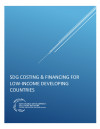Though the total SDG financing gap is daunting, on the order of an average $400 billion per year for the world’s 59 low-income developing countries (LIDCs), it amounts to just 0.7 percent of the advanced economies’ GDP, and just 0.4 percent of the world economy as a whole. In this paper, SDG Costing and Financing for the LIDCs, SDSN proposes a plausible portfolio of financing actions that would increase budget revenues for SDG outlays by $430 billion—enough to close the SDG financing gap in all LIDCs and end extreme poverty.
Of course, collecting and distributing these incremental sources would be a huge political lift. Nevertheless, the basic point is clear: the world is rich and can afford to enable the LIDCs to meet their fiscal requirements for the SDGs. The proposed portfolio of incremental SDG financing mechanisms (with targeted incremental dollar flows in parentheses) include:
- mobilizing private investments in blended financing, particularly for SDG infrastructure needs ($50 billion);
- mobilizing increased revenues earmarked for SDG expenditures by closing international tax loopholes ($50 billion);
- introducing globally harmonized taxes, such as wealth taxes for ultra-high net worth individuals ($100 billion);
- financial transaction taxes ($50 billion);
- carbon taxes ($50 billion);
- increasing and better targeting official development assistance ($100 billion); and
- expanding private philanthropy, particularly through the Giving Pledge ($30 billion).
These quantitative targets are very preliminary at this stage and should be further substantiated by the SDG financing community. While some will say it is unrealistic to pursue all financing options at once, in a very rich world, aiming for anything less than the deployment of all viable financing tools would be reckless and irresponsible.
